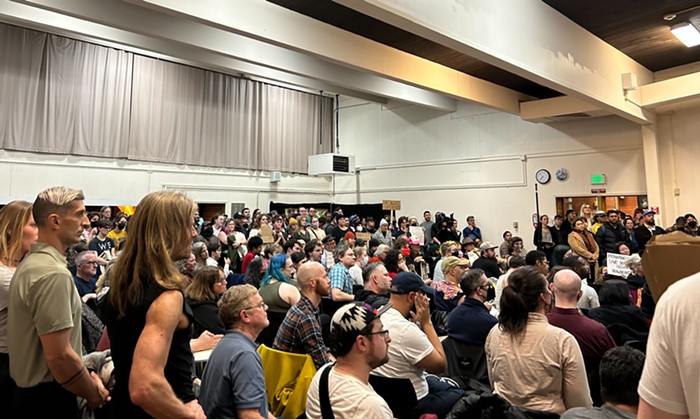For one, the essence is easy to understand: Two guys struggle in a ring. They will lose if they touch the ground inside the ring with anything other than the soles of their feet, or touch the ground outside the ring. Following the action is a breeze.
Also, the part of me that loves ramification and arcana is satisfied by sumo. For instance, each way of forcing your opponent out of the ring or getting him to touch down is considered a special technique. And of course each technique has a name and a history; each wrestler has his favorite techniques and vulnerabilities. There's no lack of fine detail if that's what you're looking for--even as the sand for multitude.
Dignity/Foolishness
When Americans think of wrestling, they think of the WWF, braining each other with stepladders and garbage cans. Sumo wrestlers are models of restraint and poise. More than a year ago, a sumo wrestler named Wakanoyama clenched his fist in irritation when a decision went against him. I guess he'll live it down someday, but not soon.
One of the chief impediments to dignity in American sports coverage is commercial sponsorship. On NHK, the Japanese TV network, there are no commercials during sumo broadcasts: none. Asahi beer and JAL airline spots run before and afterward. Sponsors are allowed to give special prizes. Before the sponsored match, special sumo peons walk once around the ring, each carrying a banner with a sponsor's name and message and perhaps an image on it. After the match, the winner makes a small prayerful motion over the envelope containing the prizes, takes it, and hands it to his assistant. No further mention is made of the prize-giver.
But I don't want to give the impression that sumo is all chastity and faded violets. There's a goofy pageantry to the sport that I find captivating. For instance, the referees wear kimonos of staggering splendiferousness, said to cost in the multiple tens of thousands of dollars, and adorable little black foldy hats, like origami. You can find referee dolls on eBay, often misidentified as geishas. Each referee presides over two matches; there are usually 20 matches in an evening, so you get to see lots of great referee costumes.
The referee says only two things during a match, but he says them over and over: "You're still in you're still in you're still in you're still in," to assure the wrestlers that the match is still in play; and, "Get moving get moving get moving," on those rare occasions when there's a deadlock. Immediately at the end of a match he must motion to the winner. If his ruling is in doubt, five black-clad judges gather in the center of the ring to discuss it. The referee carries a dagger to kill himself if his ruling turns out to be wrong, but these days he just offers his resignation.
A sumo tournament lasts 15 days. There are approximately 40 wrestlers, and everybody fights every day--there's no elimination. The sumo committee decides who fights whom, on the basis of what matches will make for the most exciting sumo. The wrestler who wins the most matches wins the tournament. If two or more guys tie for the most matches, the playoff happens immediately, King of the Mountain style.
As soon as there's a winner, the presentation ceremonies begin. The Emperor's Cup and many of the other awards are sized for sumo wrestlers, but the presenters are government lackeys. Again and again you have the spectacle of a wizened, elderly bureaucrat tottering under the weight of what looks for all the world like a gargantuan bowling trophy. It's not dignified, but at least it's novel.
Up Close and Impersonal
Did you watch the Olympics on American TV? Apparently the broadcasters have decided (a) that they need a female audience, and (b) that the only coverage women want is People magazine. Last time I checked, I was female, but I don't seem to match their focus groups. I do like knowing the people in a sport, but as athletes, not as sob stories.
Because everybody fights every day, in different combinations, a sumo tournament has a novelistic feel. As the 15 days progress, the newcomers become familiar. We see our favorites recovering from injuries, trying new techniques, encountering old foes once again--it's very like the later chapters in a Trollope novel, only of course with massive half-naked combatants instead of country parsons sipping tea.
There is sometimes a tiny bit of background coverage. A sumo wrestler traditionally maintains a connection to the place of his birth, and occasionally after a particularly triumphant bout there will be a shot or two of his local fan club. It's felt that a sumo wrestler's first tournament after he gets married is likely to be particularly tense, or meaningful, or something along those lines. That's about it for intrusive personal observation.
The sumo interview is a little art form all its own. Sumo wrestlers have their clichés down pat: "My opponent was very good, very good," or "I was happy to have a chance to do my sumo." You have to learn to read whole shoals and depths of personality in the angle of the head, the number of blinks, the breadth and symmetry or crookedness of a smile.
The Thing Itself
Before the match, each wrestler rinses his mouth out and wipes his body. He raises his arms and stamps his feet. He scatters a handful of salt. The two wrestlers come to the center of the ring, squat, and face each other, crouching forward and often glaring. They go back to their corners for more salt, scatter it, and return to glare some more. All these actions have symbolic meaning, but for the spectators they mean time to get ourselves worked up.
Sumo is pretty close to no-holds-barred. A few things are forbidden--eye gouging, hitting with the fist, biting, hair pulling, choking, kicking in the stomach or the chest, hitting both ears at the same time, attacks on the genitals. Everything else is allowed. If you can imagine it, they can do it.
Sumo structures the whole year. There's a tournament every two months, starting in January. So sumo addicts have 15 days of intense sumo activity followed by six weeks off, and then 15 days of sumo again. Sumo is to the sumo fan what the sea is to the Irish--never far away.
How to Watch
I pay Dish Network an extra $25 a month to get NHK, the Japanese TV network, which works out to a little more than 15 cents a bout, but of course I want to watch every bout. Before you start handing out that kind of money, you'll want to watch in a public place. I've telephoned a large number of Japanese restaurants in Seattle, asking whether they have TVs and whether they get NHK. Nearly all of them have pointed me to the one place I knew already--Uwajimaya.
Both the Uwajimaya in the International District and the one in Bellevue keep their TVs tuned to NHK during sumo tournaments, and you can easily insert yourself into a nest of fans. Cheering consists mainly of calling out the name of the wrestler you want to win the current match, like "Toki! Toki!" or "Dejima! Dejima!" I loved the wrestler Musashimaru from the first time I saw him, but I didn't get how to say his name. People smiled cheerfully when I called out something along the lines of "Mushi! Mushi! Rama!" and nobody chased me away.
Do you need to speak Japanese? Not at all. In a short while you'll come to recognize the names of the wrestlers and some of the most common techniques for winning. It doesn't matter that you have no pronouns and prepositions to string them together into sentences. NHK does have an English-language feed, but the commentary doesn't add to the experience; think Macy's Thanksgiving Day parade and then dumb it down a notch. I prefer to watch in Japanese.
So mark your calendar--the next tournament starts on November 5. It will be here any minute.
Barley Blair is the pseudonym of a little old lady who has never been misidentified as a geisha.


















